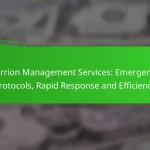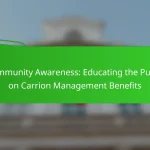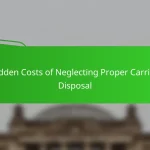Effective carrion management in urban areas is essential for enhancing community health and safety. By educating the public on the benefits of proper disposal of animal remains, communities can reduce health risks and create a cleaner environment. Engaging local residents through workshops and social media can foster awareness and encourage participation in sustainable practices.
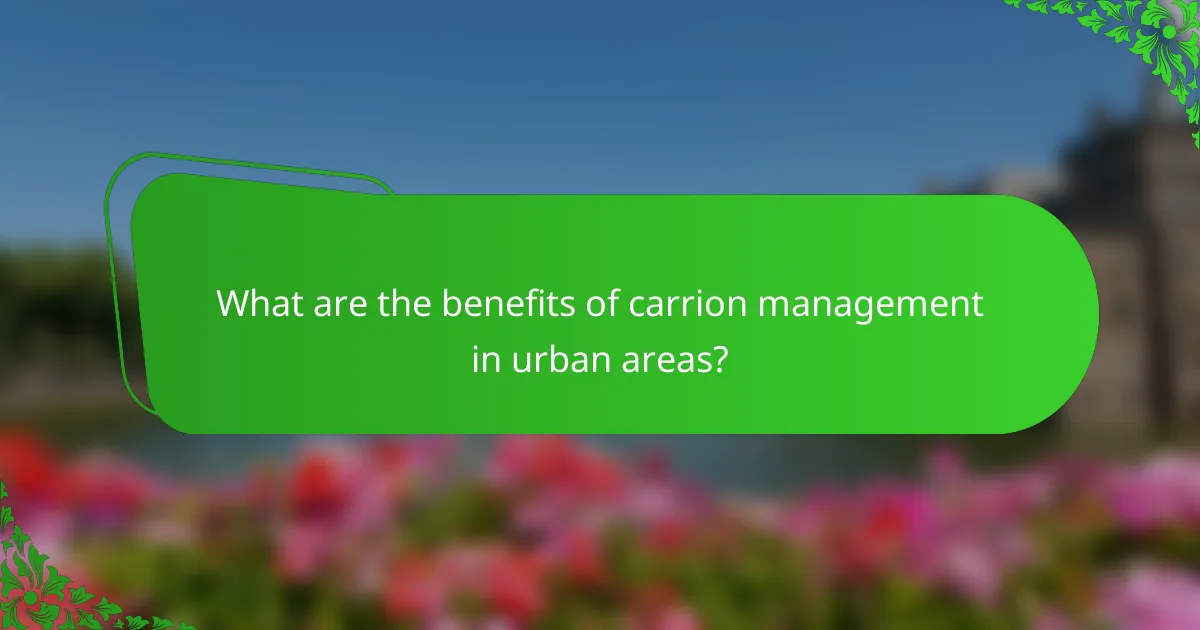
What are the benefits of carrion management in urban areas?
Carrion management in urban areas offers significant advantages, including reduced health risks and enhanced community environments. Properly managing animal remains can lead to safer public spaces and improved quality of life for residents.
Reduces disease transmission
Effective carrion management plays a crucial role in minimizing the spread of diseases associated with decaying animals. By removing carcasses promptly, urban areas can significantly lower the risk of zoonotic diseases, which can be transmitted from animals to humans.
Common diseases linked to carrion include leptospirosis and rabies, which can thrive in environments where animal remains are left unattended. Regular monitoring and swift removal of carrion can help prevent outbreaks and protect community health.
Improves public health
Public health benefits from carrion management are substantial, as it directly impacts the overall well-being of residents. A clean environment reduces the likelihood of pest infestations, such as rodents and insects, which can carry diseases.
Moreover, maintaining a hygienic urban landscape fosters a sense of safety and comfort among residents. Communities that prioritize carrion management often experience lower healthcare costs related to disease treatment and prevention.
Enhances community aesthetics
Proper carrion management contributes to a more visually appealing urban environment. Removing unsightly animal remains helps maintain the beauty of parks, streets, and public spaces, making them more inviting for residents and visitors alike.
Communities that actively engage in carrion management often see increased property values and a stronger sense of community pride. Clean and well-maintained areas encourage outdoor activities and social interactions, enhancing the overall quality of life.
Supports local ecosystems
Managing carrion effectively supports local ecosystems by ensuring that decomposing animals do not disrupt the balance of urban wildlife. When carcasses are removed promptly, it prevents scavengers from congregating in unhealthy numbers, which can lead to competition for resources.
Additionally, proper carrion management can promote biodiversity by allowing native species to thrive without the negative impacts of disease and overpopulation. This balance is essential for maintaining healthy urban ecosystems that benefit both wildlife and residents.
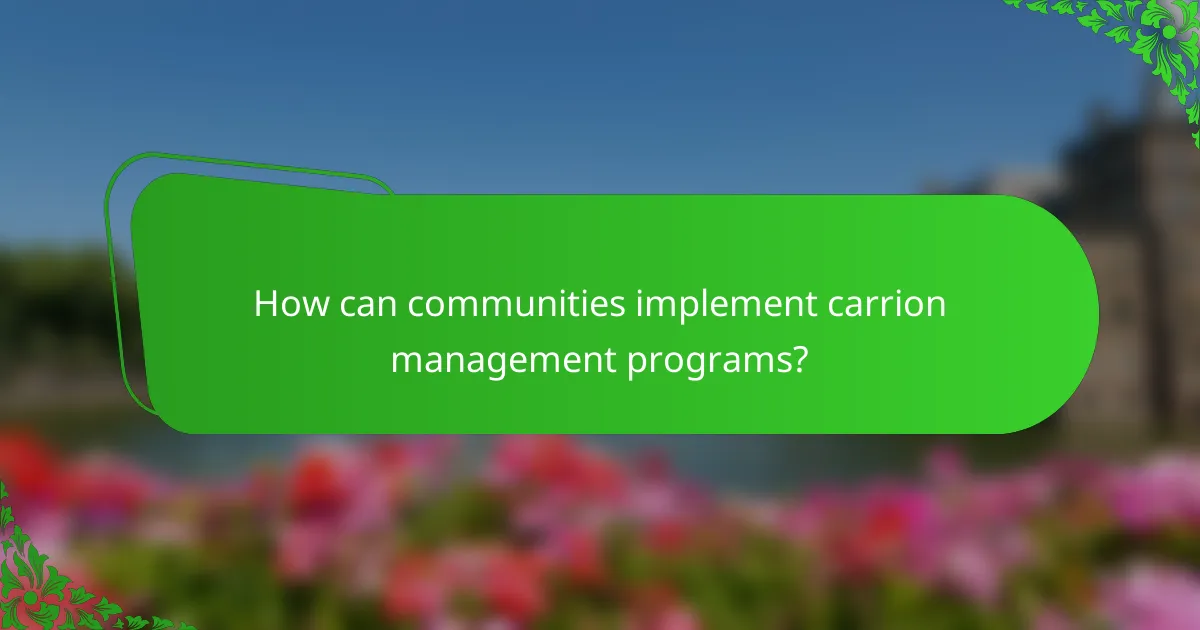
How can communities implement carrion management programs?
Communities can implement carrion management programs by raising awareness, collaborating with relevant agencies, and engaging local volunteers. These steps help ensure effective handling of animal remains, reducing health risks and promoting environmental sustainability.
Establish local awareness campaigns
Local awareness campaigns are essential for educating residents about the importance of carrion management. These campaigns can include workshops, informational flyers, and social media outreach to inform the public about safe disposal methods and the ecological benefits of proper carrion management.
Consider partnering with schools and community centers to host events that demonstrate the impact of carrion on local ecosystems. Engaging storytelling and visual aids can enhance understanding and encourage community participation.
Collaborate with wildlife agencies
Collaboration with wildlife agencies is crucial for effective carrion management. These agencies can provide expertise on local wildlife habits and the ecological implications of carrion disposal. They may also assist in developing guidelines that align with regional regulations.
Communities should seek to establish formal partnerships with these agencies to facilitate training sessions and resource sharing. This collaboration can help streamline response efforts when dealing with larger animal carcasses and ensure compliance with environmental standards.
Utilize community volunteers
Engaging community volunteers can significantly enhance carrion management efforts. Volunteers can assist in monitoring local areas for animal remains and participate in cleanup initiatives. This not only helps maintain public health but also fosters a sense of community responsibility.
To effectively utilize volunteers, communities should provide clear guidelines and training on safe handling and disposal practices. Organizing regular volunteer days can help maintain momentum and ensure ongoing community involvement in carrion management efforts.

What are effective educational strategies for carrion management?
Effective educational strategies for carrion management include workshops, social media outreach, and partnerships with schools. These methods help raise awareness about the benefits of proper carrion disposal and promote community involvement in sustainable practices.
Workshops and seminars
Workshops and seminars provide hands-on learning experiences that can effectively engage community members. These events can cover topics such as the ecological impact of carrion, safe disposal methods, and the importance of reducing scavenger attraction.
To maximize participation, consider hosting these sessions at local community centers or parks. Offering incentives like free materials or refreshments can also encourage attendance.
Social media outreach
Social media outreach is a powerful tool for spreading awareness about carrion management. Platforms like Facebook, Instagram, and Twitter can be used to share informative posts, videos, and infographics that highlight best practices and the benefits of proper management.
Regular updates and interactive content, such as polls or Q&A sessions, can keep the community engaged. Collaborating with local influencers can also amplify the message and reach a broader audience.
Partnerships with schools
Forming partnerships with schools can help integrate carrion management education into existing curricula. Engaging students through projects or field trips can foster a sense of responsibility and awareness from a young age.
Consider developing educational materials that teachers can use in the classroom, such as lesson plans or activity guides. Involving students in community clean-up events can also reinforce the importance of proper carrion disposal and environmental stewardship.

What role do local governments play in carrion management?
Local governments are crucial in carrion management as they establish policies, allocate resources, and engage the community to ensure effective handling of animal remains. Their involvement helps maintain public health, environmental safety, and community awareness regarding the benefits of proper carrion management.
Policy development
Local governments develop policies that outline the procedures for carrion management, including reporting, removal, and disposal. These policies often align with public health regulations and environmental standards to minimize risks associated with decaying animal matter.
For example, a municipality may implement a policy requiring residents to report dead animals to a designated authority within a specific timeframe. This ensures timely removal and reduces the potential for disease transmission.
Resource allocation
Effective carrion management requires adequate resources, which local governments must allocate appropriately. This includes funding for personnel, equipment, and disposal facilities necessary for handling animal remains safely and efficiently.
In many cases, local governments may partner with waste management companies to streamline the process. This collaboration can lead to cost savings and improved service delivery, ensuring that carrion is managed quickly and responsibly.
Community engagement initiatives
Community engagement is vital for successful carrion management, as it raises public awareness and encourages participation in reporting and managing dead animals. Local governments often organize educational campaigns to inform residents about the importance of timely reporting and safe disposal practices.
Additionally, workshops and informational sessions can empower community members to take an active role in carrion management. By fostering a sense of responsibility, local governments can enhance public cooperation and improve overall outcomes in managing animal remains.

How can residents contribute to carrion management?
Residents play a crucial role in carrion management by actively reporting dead animals, participating in cleanup initiatives, and educating their neighbors about the importance of proper disposal. These actions help maintain public health and environmental safety.
Report dead animals to authorities
Reporting dead animals to local authorities is essential for effective carrion management. Residents should contact animal control or local government services to ensure timely removal, which helps prevent health hazards and attracts pests.
When reporting, provide specific details such as the location, type of animal, and any visible hazards. This information allows authorities to respond quickly and efficiently.
Participate in cleanup events
Joining community cleanup events is a proactive way to contribute to carrion management. These events often focus on removing dead animals and litter from public spaces, improving the environment and community aesthetics.
Residents can check local community boards or social media for upcoming cleanup events. Participating not only helps the environment but also fosters community spirit and awareness.
Educate neighbors
Educating neighbors about the importance of carrion management can significantly enhance community efforts. Share information on how to report dead animals and the potential health risks associated with improper disposal.
Consider organizing informal gatherings or distributing flyers that outline best practices for dealing with dead animals. Encouraging open discussions can lead to a more informed and proactive community.

What are common misconceptions about carrion management?
Many people mistakenly believe that carrion management is unnecessary or that it poses health risks. In reality, effective carrion management can enhance public health and environmental sustainability by reducing disease vectors and promoting natural decomposition processes.
Carrion management is only for rural areas.
A common misconception is that carrion management is only relevant in rural settings. In fact, urban areas also face challenges related to dead animals, which can attract pests and pose health risks. Proper management practices are essential in both environments to mitigate these issues.
Carrion management is harmful to wildlife.
Some believe that managing carrion disrupts local wildlife. However, responsible carrion management can actually support ecosystems by providing food sources for scavengers like vultures and raccoons. This helps maintain a balanced food web and promotes biodiversity.
It’s too costly to implement effective carrion management.
Many assume that carrion management requires significant financial investment. While there are costs involved, the long-term benefits—such as reduced disease outbreaks and improved public health—often outweigh the initial expenses. Communities can explore cost-effective strategies, such as community-based programs and partnerships.
All dead animals must be removed immediately.
There’s a belief that all dead animals should be removed as quickly as possible. While prompt removal is essential in some cases, allowing natural decomposition in certain environments can be beneficial. This process can enrich the soil and provide nutrients to plants, contributing to ecosystem health.
